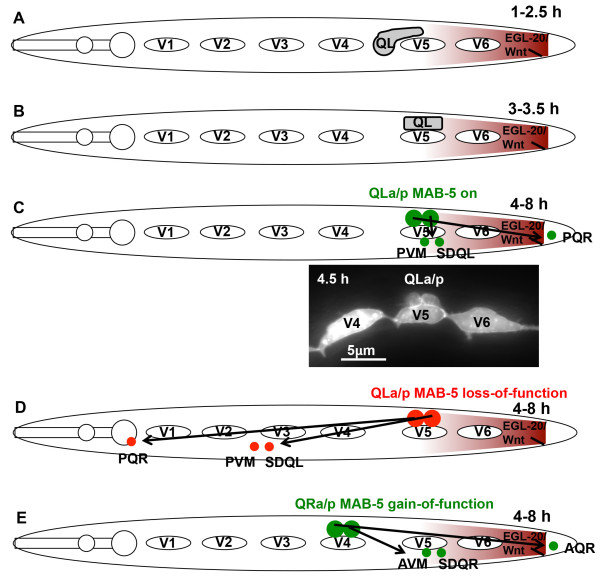Figure 1.
Q neuroblast migrations in wild type and mab-5 mutants. Schematic diagrams of Q neuroblast migrations are shown. Anterior is to the left. V1-V6 represent the hypodermal seam cells, and the Q neuroblast and its descendants are labeled. The posterior EGL-20/Wnt signal is indicted as a maroon gradient. A-D are diagrams of QL. E is a diagram of QR. A) In wild type at 1-2.5 h post hatching, QL protrudes posteriorly over the V5 seam cell. B) In wild type at 3-3.5 h post hatching, QL migrates posteriorly and resides on top of the V5 seam cell. C) In wild type, QL divides at 4 h post hatching and begins to express mab-5 induced by the posterior EGL-20/Wnt signal (indicated by a green cell). Over the next four hours, the QLap descendants undergo a pattern of division and migration resulting in three neurons, PVM, SDQL, and PQR. The diagram is simplified, showing only the final neurons and not the individual divisions and cell deaths that result in the three neurons. The micrograph is of QLap visualized by lqIs80[scm::gfp] at 4.5 hours after hatching after QL division and at a time when mab-5 expression is induced in QLap. Note that V5 has not yet divided, which occurs at approximately 5 h post hatching. D) In mab-5 loss of function, the absence of mab-5 activity (red) results in QLap and descendants migrating anteriorly instead of posteriorly, despite normal initial QL migration posteriorly over V5. PQR migrates anteriorly to the normal position of AQR on the right side. E) In mab-5(e1751) gain-of-function, mab-5 expression in QR (green) results in posterior migration of QRap and descendants despite normal initial anterior migration of QR on top of V4. AQR migrates posteriorly to the normal position of PQR on the left.

